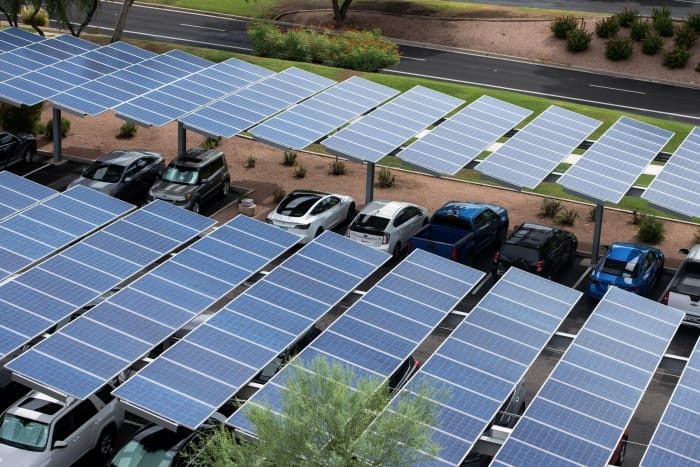Carbon is a planetary paradox. As the foundation for DNA, carbon is essential for all life on Earth. Yet, as part of the compound carbon dioxide, too much of it has built up in our air, threatening life on Earth as well.
Today, carbon-based fuels power our very way of life. They support the global economy, transport networks and energy infrastructures. Addressing our carbon problem is, in a word, complex.
READ MORE: The Top 100 Lawyers in Arizona for 2024
DEEPER DIVE: The 100 Best Doctors in Arizona for 2024
Fortunately, it’s also a problem we can solve together.
At Arizona State University, researchers explore many ways to reduce atmospheric carbon. And by working alongside industry, government, nonprofits and communities, they’re seeking solutions that are good not just for the planet but also human well-being.
Experts from fields across ASU share how we can start to bring these systems into harmony and build a healthier world for ourselves and our children.
Why is carbon dioxide a problem?
Our planet has an elegant system to recycle carbon. After making its way through plants, animals, soil, rock and ocean, it goes into the atmosphere — mainly as carbon dioxide — where it begins its journey again.
But if Earth is so great at recycling carbon, how did we end up with too much in the atmosphere?
Around 200 years ago, a key disturbance unbalanced this cycle. People found they could extract oil and coal — two forms of carbon called fossil fuels — and burn them for energy.
In short time, our way of life came to depend on carbon-based fuel. Many of today’s amenities, like long-distance travel, buying food grown far away and lighting our homes, rely on this fuel.
But these innovations have a hidden cost. As we burn fossil fuels, we release carbon back into the air, bypassing a natural process that would have taken thousands of years.
From pre-industrial times to 2021, humans have added an extra 1.69 trillion metric tons to the atmosphere, and scientists estimate we added around 37 billion metric tons in 2022 alone.
CO2 naturally traps heat, so all that extra CO2 increases Earth’s average temperature. This has noticeably affected our climate and weather patterns. These changes increase flood and fire risk, threaten crops and food security, endanger vulnerable species, expose us to new diseases, and force people to leave their homelands.
Whether your top concern is making dinner for your family, protecting your health or paying your electric bill, that extra carbon dioxide affects you.
Efforts to decrease carbon dioxide in the air, called decarbonization, currently focus on two main areas: emitting less carbon dioxide, and removing it from the air. But these tasks aren’t simple — they involve many tightly connected systems, and success in one area depends on success in others.

How can we reduce carbon emissions?
One way to address the carbon dioxide problem is to just stop emitting carbon dioxide.
But even in a future without carbon pollution, we will still need fuel and electricity. This leaves us needing to replace many carbon-powered systems with sustainable alternatives. That’s where new energy technology comes in.
“There are solutions for every industry, but they’re going to be different,” says Nicholas Rolston, an assistant professor in the School of Electrical, Computer and Energy Engineering.
Electricity generation is one area with great potential for transformation. From 2005–2020, the move away from coal power and toward renewables reduced the U.S. electricity sector’s greenhouse gas emissions by 40%, according to Environmental Protection Agency inventory.
Solar energy technology has been a major contributor to these efforts. ASU has been a hub for solar research, testing and wide-scale use for the past seven decades.

“In principle, we could generate enough electricity for the whole country if we just put solar panels in a 100-by-100 kilometer area in the middle of the desert. But then the challenge is how to distribute that. And if it’s a cloudy day, then there’s no energy for the whole country. So it becomes beneficial to have distributed solar energy,” Rolston says.
His lab is working on making household solar energy panels more affordable, easier to install and simpler to build.
“We’re trying to develop the processes that allow us to print solar panels like newspaper on this roll of plastic sheets,” he says. “Imagine having a solar panel that’s like carpet where you can just unroll it on a rooftop. It would change the economics of how we manufacture and install solar technology.”
Another area where green energy technology can make a big difference is in transportation. Electric cars have little emissions, though the electric grids that charge them might. This makes sustainable electricity even more important.
Alternative fuel can also reduce emissions from planes, cargo ships and other parts of the heavy transportation industry. Hydrogen fuel, which produces only water when consumed in a fuel cell, and biofuel, which uses renewable biomass like algae to create low-carbon fuel, are two promising options.
Read more: Empowering algae to shape the future of bioenergy
Finally, industry accounts for over 30% of U.S. greenhouse gas emissions, making this sector another major area of opportunity.
The U.S. Department of Energy recently chose ASU to lead a new DOE Clean Energy Manufacturing Innovation Institute that will reduce carbon emissions from industry.
The institute, called Electrified Processes for Industry Without Carbon (EPIXC), will create ways to use electricity for process heating such as pasteurizing milk or melting down steel. It will also provide education and workforce development to support the new technology, with a focus on underserved communities.
How does carbon capture work?
Imagine a burst pipe has flooded your basement. Turning off the water supply and repairing the pipe solve one part of the problem. But you still have a six-inch pool of water to deal with afterward.
When we want to fix the extra CO2 in our atmosphere, we face a similar scenario.
Decreasing our CO2 emissions through clean energy and lifestyle changes takes care of the overflow problem. But how do we get rid of the CO2 that has already built up?
“We need technology that can take the CO2 out of the air, and that allows us to start erasing historical CO2 emissions,” says Matthew Green, director of the Center for Negative Carbon Emissions in the Global Futures Laboratory and associate professor in the School for Engineering of Matter, Transport and Energy.
Additionally, transforming our energy systems in a way that is fair and beneficial to all will take some time. Carbon capture can help bridge that transition.
Professor Klaus Lackner, founding director of the center, pioneered the idea of direct air capture to reduce atmospheric CO2. With the help of commercial partner Carbon Collect, Lackner brought his research to life with the company’s creation of the MechanicalTree.
The machine is a metal column with layers of special sorbent material that collects carbon from the air as it passes through. The first operational MechanicalTree is located on the ASU Tempe campus.
A new frontier in carbon capture, called marine carbon dioxide removal, takes CO2 out of water from the ocean. The ocean is the world’s biggest carbon sink; it absorbs about 30% of atmospheric CO2.
As people have emitted more CO2 over the past 200 years, the ocean has had more to absorb. CO2 goes through chemical changes when absorbed in seawater, and this makes the water warmer and more acidic. This poses many challenges to life in our oceans and to important ocean currents.
Green’s new project, funded by the Office of Naval Research, will explore two ways to remove CO2 from seawater being processed into fresh water. His team will develop a polymer membrane that lets water pass through while filtering out both salt and carbon dioxide.
Once carbon is captured, it needs to go somewhere. The most common method takes the carbon and buries it in the ground. The idea is that Earth’s natural carbon cycle will gradually process it over time, although the movement of carbon in soil can be unpredictable. Therefore, scientists are also finding ways to turn it into useful, economically viable products.
“We have projects where we feed it to algae, and then the algae can convert the carbon dioxide into things like biofuels or pharmaceuticals. We have two new Department of Energy projects to convert carbon dioxide into methanol as a precursor for fuel production,” Green says.
How much does it cost to go green?
One of the top concerns for green energy transition is whether it will harm economic growth or our standard of living.
“There are the people who think it’s going to destroy everything, and the people who think it’s going to be totally costless,” says Alexander Hill, a clinical associate professor in the W. P. Carey School of Business. “The truth is somewhere in the middle. It is not going to bankrupt the country, but it will raise the price of electricity.”
Additionally, switching to green energy could increase the cost of goods and restrict supply — a similar effect as an oil price increase, Hill explains. The upside: The switch could save a lot of money elsewhere.
Hill’s recent project ran the numbers on a hypothetical scenario in which the government requires people to choose electric over nonelectric heating — like natural gas or propane — when replacing the system in their home. He found it would save several billion dollars in environmental damages every year from now through 2050.
Policies like this are being proposed across the U.S., and last year, the state of New York became the first to ban natural gas furnaces and stoves in new buildings.
Overall, Hill sees a conversion to green energy as a positive not only for the environment, but for the economy as well.
Historically, major investments like the war effort during World War II or suburban development in the 1950s brought on periods of economic growth, Hill says. Building out a green energy system over the next decade could create a smaller but similar effect, he argues.
What are the goals of environmental justice?
As we switch to green energy, we risk overlooking the most affected communities. People such as the employees of an oil refinery, a neighborhood near a power plant or families struggling to pay electric bills could be left behind if the energy transition is built over them instead of with them.
The good news is that, as we redesign our energy system, we also have the chance to redesign the policies that ignored these groups in the past.
“Policy is a strong determinant of the equity and justice of decarbonization more so than the technologies,” says Danae Hernandez-Cortes, an assistant professor in the School for the Future of Innovation in Society and the School of Sustainability in the College of Global Futures. “How can we create safeguards such that the historically disadvantaged communities can benefit from the carbon transition?”
For example, we may want people to buy electric vehicles to decrease their personal CO2 emissions. But if low-income families can’t afford to buy those vehicles, then their communities will still face the same amount of pollution.
“The literature has found in many contexts in the U.S. that low-income and minority communities are facing the highest amount of pollution,” Hernandez-Cortes says. “I think it’s important to look at decarbonization technology and policy together; otherwise, we are at risk of exacerbating some of the existing disparities.”
Her current project focuses on designing electric transit in Maricopa County that meets people’s needs and reduces their pollution exposure.
Participating in community-based groups that advocate for environmental and green energy policies is one of the most practical and powerful ways to get involved, says Hernandez-Cortes, as well as attending town or city hall meetings.
The main thing to remember is that big changes come from local efforts. The federal government can give incentives to decarbonize, but policies will play out differently from place to place.
“There’s no single policy that we know that will work nationally in every single context. We have to create policies in communities that are relevant for their context,” says Hernandez-Cortes.
Can we change our ways?
Our relationships with technology guide the way we build our cities, organize our society and form our daily routines.
For example, today in Phoenix, it is much easier to get groceries, go to work and visit friends if you use a car than if you use public transit. Society has created an environment that makes us dependent on cars.
“Our choices, our values and our behaviors get translated into carbon emissions through the technological systems that we use to live our lives,” says Clark Miller, a professor in the School for the Future of Innovation in Society.
Changing our relationships with technology for a greener future means improving both the technology itself as well as how appealing and accessible it is.
With some creativity, there is also plenty of room for adding to the value of this technology. Miller works with the nonprofit Land Art Generator, which holds design competitions to make solar energy into beautiful and useful public structures.
“Historically, we have used decarbonization as our primary and only goal for policies,” he says. “When we’re designing these clean energy projects, we need to evaluate them for their carbon impact, but we also need to evaluate them for their social and economic impact.”
To better consider these impacts, Miller holds imaginative exercises with community members. These exercises prompt participants to picture Arizona’s green future and how different strategies might play out.
Last spring, people from electric utilities, city leadership, academia and community advocacy groups gathered to discuss strategies for charging millions of electric vehicles in Phoenix’s future.
“We have to develop a much richer and more robust capacity for imagining the future in order to be able to make good decisions about how to transition our energy system,” says Miller.



